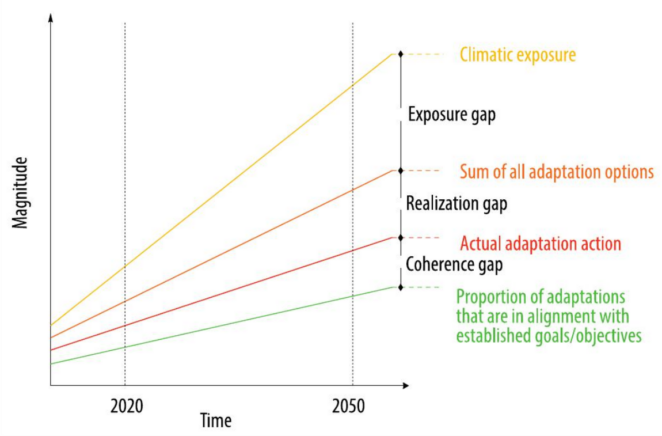Closing the Adaptation Gap in Mountains

Introduction
Adaptation in mountain areas is an urgent priority. Warming rates in many mountain areas are higher than the global average, leading to the rapid recession of mountain glaciers, changes in the availability and quality of freshwater, increases in geophysical hazards, and alterations of mountain ecosystems. Such changes are projected to intensify in coming years, but they are already impacting mountain biodiversity, eroding ecosystem services, and increasing risks associated with living in mountains, compounding the socioeconomic difficulties already gripping many mountain populations. It calls attention to the pressing need to know more about the characteristics of existing adaptation efforts, as well as prospects for increasing the quantity and quality of adaptation action in mountain communities at the frontlines of climate change. The lives of more than 1 billion people living in mountain areas are at stake.
The article shows how a focus on adaptation gaps can enrich understanding of the relationship between adaptation and mitigation, the characteristics of existing adaptation efforts, and strategic opportunities for ensuring more just and sustainable futures for those living in mountain areas.
*This article is an abridged version of the original article entitled “Closing the Adaptation Gap in Mountains” published in Mountain Research and Development, Vol 41(Number 3), under theCC BY license.© 2021 McDowell et al. Please note that references have been removed.For more detail, full references, and to quote text please use the paper available for download on the right.
Methods and Tools
The “total adaptation gap” is calculated using three components: the “exposure gap”, the “realization gap”, and the “coherence gap”.
The “exposure gap” refers to the difference between the magnitude of climatic stimuli and the sum of all adaptation options. Adaptation options are defined as including available support for formal adaptation initiatives (planned adaptations) as well as responses carried out without a formal adaptation plan (autonomous adaptations) that have an explicit but not necessarily exclusive focus on addressing climate change. The upper threshold of adaptation options is reached when hard limits, render further adaptation action infeasible, ineffective, or unacceptable.
Notwithstanding hard limits, the ability of social actors to realize currently available options is also constrained by soft limits, such as poor access to higher education, information, or financial capital. We term the difference between potential and actual levels of adaptation the “realization gap.”
Adaptations can also fall short in terms of their alignment with priorities and goals established in global agreements relevant to adaptation, such as the Paris Agreement’s Global Goal on Adaptation. Such responses can prove maladaptive in the long term, entrenching existing inequities or resulting in adverse ecological outcomes. We term this the “coherence gap.”
The “total adaptation gap” is the sum of the exposure, realization, and coherence gaps (as seen below).


Outcomes and Impacts
Closing the adaptation gap in mountains
Closing the exposure gap
The most obvious way to begin closing the exposure gap in mountains is to increase mitigation efforts. However, even with aggressive mitigation efforts, the lag between emission reductions and effects on the climate system, the magnifying effects of elevation-dependent warming in mountain areas, and the high sensitivity of many mountain communities to climatic exposures suggest that mitigation alone will not be sufficient.
Closing the realization gap
The availability of major adaptation support and the potential for high levels of autonomous adaptation are necessary but not sufficient conditions for closing the exposure adaptation gap; actual progress in this regard requires addressing the realization gap. Here, identifying, understanding, and ameliorating soft limits to adaptation are key steps.
Closing the coherence gap
While closing the realization gap is essential, without adaptations that are evidence-based, equitable, and sustainable, responses to climate change may fail to achieve their goals, have unintended consequences, or be maladaptive. Closing the coherence gap requires addressing observed deficiencies in adaptation action.
Outlook for adaptation in mountains
The size of the total adaptation gap indicates the magnitude of the adaptation challenge in mountain areas at a given point in time. However, by breaking this challenge down into constituent adaptation gaps, we begin to see pathways for achieving more equitable, sustainable, and climate-resilient futures.
Progress can be made in closing adaptation gaps in mountains through aggressive mitigation action and by increasing the quantity and quality of adaptations. Ultimately, however, efforts to close adaptation gaps will require addressing pervasive limits to adaptation through deliberate transformative actions, particularly to remediate social issues that have long constrained the adaptive capacity of mountain people. However, there is growing recognition that trajectories of climate change will present hard biophysical limits that will make closing the exposure gap difficult or impossible, leading to detrimental consequences on natural and human systems and to undesirable social-ecological transformations.
Navigating these challenges and opportunities in practice will require moving beyond treating adaptations as either ‘‘planned’’ or ‘‘autonomous’’ and toward a deeply collaborative approach to adaptation planning and action that is rooted in local needs, aspirations, and ways of knowing but that is also supported by external capacity building and implementation resources. Such an approach is coherent with key tenets of the Paris Agreement, the SDGs, and the Sendai Framework, but it is rarely observed in practice. Here, the transformative knowledge sharing, coproduction, and mobilization activities being advanced by the Canadian Mountain Network are instructive. Ultimately, while there are significant opportunities for closing adaptation gaps in mountains, it is unfortunately also necessary to prepare for unavoidable losses and damages. Such preparation must be based on ethical and deliberative planning processes that give voice, support, and, where appropriate, compensation to mountain residents who bear the burden of climate change.
Related resources
- Closing the Adaptation Gap in Mountains (original article)
- Mountain Research and Development (journal website)
- Adaptation Gap Report 2020
- Adaptation action and research in glaciated mountain systems: Are they enough to meet the challenge of climate change?
- Mountain Observatories: Status and Prospects for Enhancing and Connecting a Global Community
- Adaptation to Climate Change in the Andes: gaps in understanding and opportunities for knowledge management
- Can the Least Developed Countries Count on the Green Climate Fund?
(0) Comments
There is no content